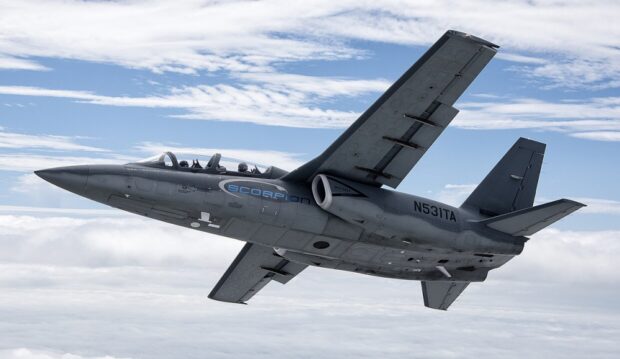The Scorpion armed reconnaissance jet from Textron Aviation is one-of-a-kind. No other tactical aircraft like it is currently in existence. The manufacturer took it upon itself to develop a unique aircraft to meet a specific need in the market no other aircraft could fulfill. In their confidence, they decided to use their own money against the norm for military aircraft development.
Typically, the government foots most of the bill and becomes the first user. But the Scorpion is not a typical aircraft. It can be built right in the US and then easily exported to countries all around the world.
At a quarter of the price of an expensive F-16, the Scorpion can cover border patrol, maritime security, drug interdiction, disaster relief, and counter-insurgency warfare roles. It may not have all the bells and whistles of a fully loaded fighter jet, but that is one of many reasons it is such an impressive aircraft.
The Textron AirLand Scorpion is an American jet aircraft proposed for sale to perform light attack and intelligence, surveillance and reconnaissance (ISR) duties. It is being developed by Textron AirLand, a joint venture between Textron and AirLand Enterprises. A prototype was secretly constructed by Cessna at their Wichita, Kansas facility between April 2012 and September 2013 and first flown on 12 December 2013.
Development
In October 2011, a group of outside investors known as AirLand Enterprises LLC approached Textron with the concept of building the “world’s most affordable tactical jet aircraft.” The two companies created a joint venture called Textron AirLand and development of an aircraft began in January 2012. Neither Textron nor its subsidiaries had much experience designing fixed-wing combat aircraft. Textron saw a market for the type: while military aircraft typically grew more expensive, defense budgets declined.
Named Scorpion, the first concept had a single engine. In early 2012, engineers reviewed over 12 design configurations that would meet their goals and shortlisted four designs; the team eventually settled on the tandem-seat, twin-engine configuration.
The aircraft was kept secret, being identified by the code name SCV12-1, or simply “the project”. At its peak, the production team was 200 people, which eventually decreased to 170, including 120 engineers. The outside contours were made in May 2012, and wing production started in August 2012. Unconventionally, wind tunnel tests were performed after wing parts were already being made. In a traditional aircraft development program, the Department of Defense or a military service would issue detailed requirements, potentially hundreds of pages long. Instead, Textron AirLand did a market and capability analysis to determine what domestic and foreign forces required but did not have.
The design team made up of personnel from Textron, Cessna, and Bell Helicopter was assembled in one building with everyone focused on the task, enabling decisions to be made in hours instead of days. To not alert any potential competitors, development was kept secret through non-disclosure agreements, obtaining parts from local suppliers, and the natural close-knit, “small town” nature of Wichita, Kansas. Technology from the Cessna inventory or other existing, readily-available components and hardware were used. In November, Textron spokesman David Sylvestre confirmed that Cessna had been involved in building the prototype Scorpion, but may not build any production models. Sylvestre stated, “depending on demand and manufacturing capacity needs, the final site of Scorpion manufacturing beyond the initial low rate production (2015) is yet to be decided. It may be built ‘at’ Cessna, but by the joint venture called Textron AirLand.”
The Scorpion was unveiled on 16 September 2013
In 2014, the development-to-flight time was expected to take 4–5 years, the goal of the first flight within at least 24 months was achieved. The phrase “speed is paramount” serves as impetus for the program, with the objective of creating the plane, flying it, and selling it as fast as possible to not miss opportunities. If a customer can be found, production could begin in 2015, and deliveries from 15 to 18 months after an order is received. The plan is to secure a contract first, then begin low-rate production and transition to full-rate production. Textron AirLand sees a market for up to 2,000 Scorpion jets.
Sources: YouTube: Wikipedia

